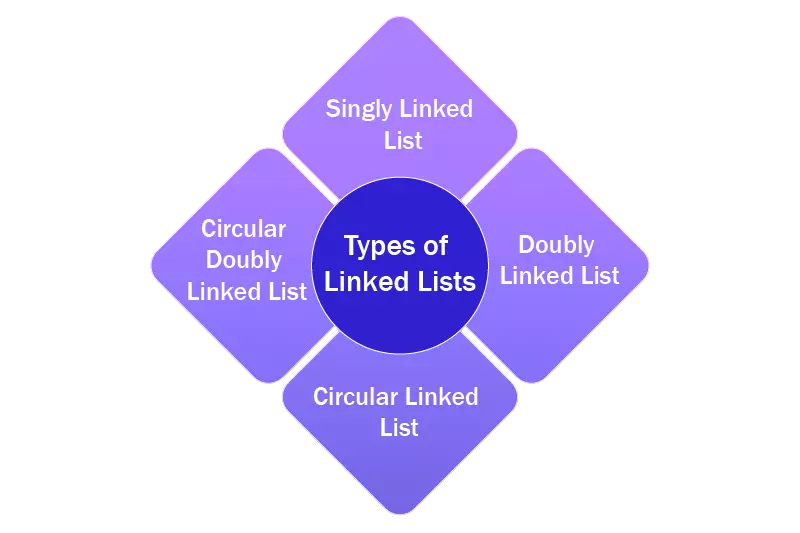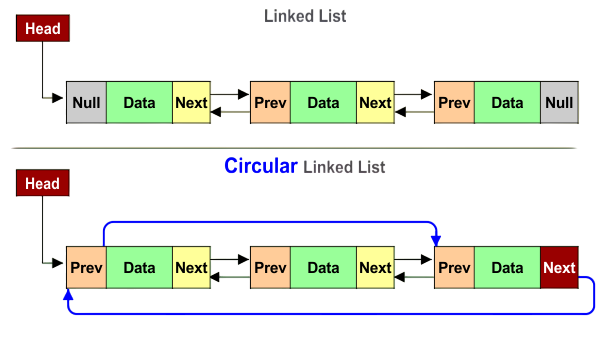
- Introduction to Linked Lists
- Types of Linked Lists
- What is a Circular Linked List
- Node Structure
- Insert Technique
- Deletion in Circular List
- Traversing a Circular List
- Applications
- Advantages & Disadvantages
- Code Implementation
- Conclusion
Introduction to Linked Lists
A linked list is a dynamic data structure consisting of nodes where each node contains data and a reference (or pointer) to the next node in the sequence. Unlike arrays, linked lists don’t require contiguous memory allocation, making them more efficient for memory management and dynamic data scenarios concepts that are foundational in Web Developer Training, where learners explore data structures, front-end logic, and performance optimization techniques. Understanding how memory models impact rendering and responsiveness is key to building scalable, user-friendly web applications. Linked lists are widely used in data structures due to their flexibility in insertion and deletion operations. They serve as the foundation for more complex structures such as stacks, queues, and graph representations.
To Earn Your Web Developer Certification, Gain Insights From Leading Web Developer Experts And Advance Your Career With ACTE’s Web Developer Courses Today!
Types of Linked Lists
Linked lists are categorized based on how the nodes are connected: singly, doubly, or circular each structure offering unique traversal and memory management benefits. These foundational data concepts align with interface logic and dynamic rendering strategies taught in Become a Front End Developer, where learners build fluency in HTML, CSS, JavaScript, and structured planning workflows. Understanding how data structures influence UI behavior is key to crafting responsive, scalable web applications.
- Singly Linked List: Each node points to the next node, and the last node points to null.
- Doubly Linked List: Each node has pointers to both the next and previous nodes.
- Circular Linked List: The last node points back to the first node, forming a circle.

Among these, the Circular Linked List is unique because it forms a continuous loop, allowing for efficient use in certain applications like buffering and round-robin scheduling.
What is a Circular Linked List?
A Circular Linked List (CLL) is a variation of the singly or doubly linked list where the last node points back to the head (first node), creating a circular structure. This circular nature removes the need for a null pointer at the end of the list and facilitates continuous traversal a structural advantage that reflects deeper data handling principles explored in Web Development Languages To Learn, where learners examine how languages like Python, JavaScript, and PHP manage memory, control flow, and dynamic rendering. Understanding these patterns equips developers to build efficient, scalable applications across modern web stacks.
Circular Linked Lists can be:
- Singly Circular Linked List: Each node has one pointer to the next node, and the last node points to the head.
- Doubly Circular Linked List: Each node has two pointers—one to the next and one to the previous node—with the last node linking to the head and vice versa.
Node Structure
Each node in a Circular Linked List typically has: a data field and a pointer to the next node, with the last node linking back to the first an efficient structure for dynamic memory scenarios, and a concept reinforced in Web Developer Training, where learners explore foundational data structures alongside front-end and back-end development. Understanding how circular references impact performance and traversal logic is key to building responsive, scalable web applications.
- struct Node {
- int data;
- struct Node* next;
- };
- // In a doubly circular linked list, the structure would be:
- struct Node {
- int data;
- struct Node* next;
- struct Node* prev;
- };
The main feature is that the last node’s next (and prev in doubly CLL) points back to the head (or tail), making the list cyclic.
Would You Like to Know More About Web Developer? Sign Up For Our Web Developer Courses Now!
Insert Technique
In circular linked lists, you can insert technique nodes using three main methods. To insert at the beginning, developers create a new node, link it to the head, and update the last node’s next pointer to point to the new head. This keeps the circular structure intact. For inserting at the end, the method involves going to the last node, linking the new node’s next pointer to the head, and updating the last node’s next reference to the new node a logic pattern that mirrors modular design principles explored in Practical Applications of Python, where learners apply Python’s versatility across domains like web development, data science, automation, and embedded systems. Mastering such structural operations equips developers to build efficient, scalable solutions in real-world environments. When inserting at a specific position, the process requires moving through the list to the chosen spot and adjusting the pointers of the previous and new nodes to maintain the list’s integrity and circular connection. These methods offer flexible ways to modify circular linked list data structures while ensuring proper node management.

- void insertAtBeginning(struct Node** head, int data) {
- struct Node* newNode = (struct Node*)malloc(sizeof(struct Node));
- struct Node* temp = *head;
- newNode->data = data;
- newNode->next = *head;
- if (*head != NULL) {
- while (temp->next != *head)
- temp = temp->next;
- temp->next = newNode;
- } else {
- newNode->next = newNode;
- }
- *head = newNode;
- }
Deletion in Circular List
In linked list operations, deletion can be done in three main ways, each suited for different situations. To delete from the beginning, you first find the last node, then move the head pointer to the next element, and finally free the original head a structural operation that mirrors foundational logic principles taught in Web Development, where learners explore how data structures, memory management, and algorithmic flow shape dynamic websites. Mastering such operations equips developers to build efficient, scalable applications with clean architecture and responsive behavior. Deleting from the end involves reaching the second-to-last node, changing its next pointer to the head, and then releasing the last node. To remove a specific node, you carefully navigate the list to find the target element. You keep a reference to the previous node and update the pointers to skip over the node you want to delete. These clear techniques help handle linked lists effectively, enabling developers to manage data connections with accuracy and less computational effort.
- void deleteNode(struct Node** head, int key) {
- if (*head == NULL) return;
- struct Node *temp = *head, *prev;
- if (temp->data == key && temp->next == *head) {
- free(temp);
- *head = NULL;
- return;
- }
- if (temp->data == key) {
- while (temp->next != *head)
- temp = temp->next;
- temp->next = (*head)->next;
- free(*head);
- *head = temp->next;
- return;
- }
- while (temp->next != *head && temp->next->data != key)
- temp = temp->next;
- if (temp->next->data == key) {
- struct Node* del = temp->next;
- temp->next = del->next;
- free(del);
- }
- }
Are You Interested in Learning More About Web Developer? Sign Up For Our Web Developer Courses Today!
Traversing a Circular List
From dynamic form builders to real-time chat interfaces, jQuery remains a powerful tool for crafting interactive web components an approach showcased in jQuery Project Ideas for Developers, where learners explore hands-on projects like personalized dashboards, image galleries with filters, and dynamic pricing tables. These ideas help developers master DOM manipulation, event handling, and AJAX integration while building portfolio-ready applications that reflect modern UI expectations.
- void traverse(struct Node* head) {
- struct Node* temp = head;
- if (head != NULL) {
- do {
- printf(“%d “, temp->data);
- temp = temp->next;
- } while (temp != head);
- }
- }
Applications
Circular Linked Lists are useful in:
- Operating Systems: Round-robin CPU scheduling.
- Multiplayer Games: Keeping track of turns.
- Buffer Management: Circular buffers in embedded systems.
- Data Streaming: Audio/Video data processing.
- Navigation Systems: Playlist cycling or image carousels.
Advantages & Disadvantages
Advantages
- Efficient Use of Memory: No need to allocate extra pointers for NULL.
- Continuous Traversal: Can be started from any node and loop through the entire list.
- Faster Rotation and Scheduling: Useful for round-based systems.
- Dynamic Structure: Like all linked lists, nodes can be added or removed dynamically.
Disadvantages
- Infinite Loops: Poor implementation can cause non-terminating loops in circular structures.
- Complex Deletion: Deleting the head or tail node requires extra care and pointer updates.
- More Pointer Management: Requires precise handling of head and tail pointers to maintain integrity.
- No Direct Access: Unlike arrays, nodes must be accessed through traversal, increasing time complexity.
Code Implementation
Here is a complete C program demonstrating insertion, deletion, and traversal:
- #include <stdio.h>
- #include <stdlib.h>
- struct Node {
- int data;
- struct Node* next;
- };
- void insertEnd(struct Node** head, int data) {
- struct Node* newNode = (struct Node*)malloc(sizeof(struct Node));
- struct Node* temp = *head;
- newNode->data = data;
- newNode->next = *head;
- if (*head != NULL) {
- while (temp->next != *head)
- temp = temp->next;
- temp->next = newNode;
- } else {
- newNode->next = newNode;
- }
- *head = newNode;
- }
- void traverse(struct Node* head) {
- struct Node* temp = head;
- if (head != NULL) {
- do {
- printf(“%d -> “, temp->data);
- temp = temp->next;
- } while (temp != head);
- printf(“HEAD\n”);
- }
- }
- void deleteFirst(struct Node** head) {
- struct Node *temp = *head, *last = *head;
- if (*head == NULL)
- return;
- if (temp->next == *head) {
- free(temp);
- *head = NULL;
- return;
- }
- while (last->next != *head)
- last = last->next;
- *head = (*head)->next;
- last->next = *head;
- free(temp);
- }
- int main() {
- struct Node* head = NULL;
- insertEnd(&head, 10);
- insertEnd(&head, 20);
- insertEnd(&head, 30);
- printf(“Circular Linked List:\n”);
- traverse(head);
- printf(“\nAfter deleting first node:\n”);
- deleteFirst(&head);
- traverse(head);
- return 0;
- }
Conclusion
Circular Linked Lists offer a unique structure with a looped connection that proves advantageous in many real-time applications. Their ability to allow circular traversal and dynamic memory handling makes them suitable for systems requiring continuous rotation, like OS scheduling and media buffering concepts that intersect with interface logic and performance optimization taught in Web Developer Training, where learners master responsive layouts, dynamic rendering, and efficient data handling across front-end environments. Understanding how structural patterns like circular lists influence UI behavior is key to building fluid, scalable web applications. However, their complexity increases in pointer management and risks like infinite loops. Understanding and properly implementing Circular Linked Lists enables developers to optimize system performance, particularly in time-sensitive and cyclic operations.



